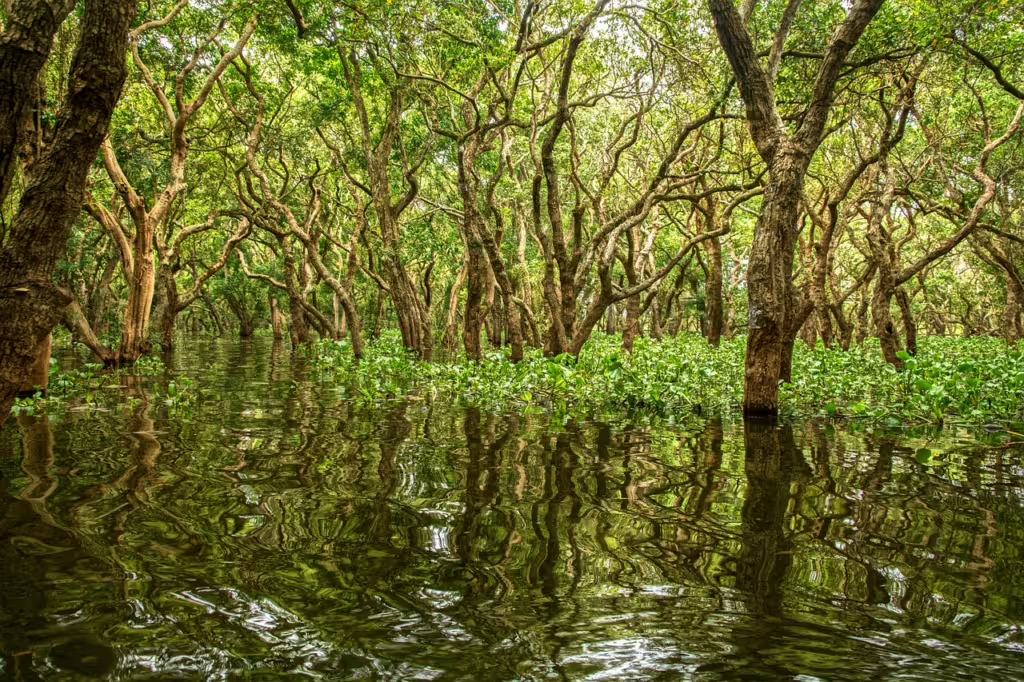Of all the adaptable species on the planet, plants stand tall amidst a tidal wave of climate change, extreme weather, and inhospitable conditions. Despite their very specific needs, plants can be found in nearly every ecosystem on the planet, from the tallest, coldest peaks, to the driest deserts in the world and even the deep ocean. They are the most versatile and resilient organisms on the planet Earth and are capable of adapting to some of the harshest conditions imaginable.
In this article, we will explore these extreme environments and learn how they push flora to develop ingenious survival strategies. We will go over the many remarkable adaptations of plants like desert cacti, alpine flowers, and other flora that thrive, even in places where life itself seems impossible.
Desert Dwellers: Masters of Water Conservation
Cacti: Icons of Desert Survival
Cacti are the quintessential survivors of the plant world. Nearly every species of the 1,750 species of cacti has found some way to survive and thrive in the arid desert regions they have found themselves in. Found in deserts all across the Americas, cacti have evolved a suite of adaptations to endure scorching heat, intense sunlight, and scarce water.
Water Storage: The most distinctive, and in this writer’s humble opinion, amazing feature of cacti is their ability to store water. The thick, fleshy stems of cacti are almost like a reservoir, sustaining the plant during periods of prolonged drought; a common occurrence in a place where water is generally considered to be nearly nonexistent. Some species, like the iconic saguaro cactus (Carnegiea gigantea), can store thousands of liters of water within their enormous trunks.
Spines Instead of Leaves: The reason that so many cacti possess spines instead of leaves is that because having normal leaves would lead to excessive water loss through transpiration. Spines, on the other hand, not only reduce water loss but also provide shade to the cactus and deter herbivores from gobbling up all their water-soaked fleshy parts.
Shallow but Extensive Roots: Cacti possess root systems just like any other plant, but with one distinct difference. These roots spread out widely just below the surface, rather than deeply, allowing them to absorb as much water as possible during the rare and often brief periods of rain.
Waxy Coating: The thick cuticle that surrounds a cactus’ stem helps minimizes water evaporation and reflects sunlight, keeping the plant cooler.
Other Desert Flora
While cacti tend to steal the spotlight, other plants like succulents and shrubs also equally excellent at desert survival tactics. These types of plants positively thrive in arid environments. Take for instance, the Welwitschia mirabilis, which can be found in the Namib Desert. This remarkable tree can live for over 1,000 years, absorbing moisture from fog through its leaves. Creosote bushes (Larrea tridentata) are similar, and possess another unique adaptation to help them thrive. These plants are able to produce chemicals that inhibit nearby plant growth, reducing competition for the very limited resources within the desert biome.
Alpine Survivors: Beauty in High Places
Alpine Flowers
High-altitude environments, such as those in the Himalayas or the Alps, would not be ones that the averge person might consider to be hospitable for plants. These high places are characterized by freezing temperatures, strong winds, and intense UV radiation. Yet, despite these challenges, alpine plants like edelweiss (Leontopodium nivale) and glacier lilies (Erythronium grandiflorum) are able to thrive and grow.
Compact Growth: The reason so many alpine plants can continue to grow even in the cold and wind, has a lot to do with proximity. These plants grow close to the ground in cushion-like shapes, reducing exposure to wind and allowing the entire plant to retain heat. This form of growth also helps the plant trap moisture and create a kind of independent microclimate for survival.
Fuzzy Leaves and Stems: Some alpine plants have hairy or woolly textures on their leaves and stems. This makes sense, as mammals use hair to protect themselves from the cold and insulate their bodies. The same is true for these plants, whose “hair” protects them from the cold winds of the mountains. It also has the added benefit of reducing water loss.
Antifreeze Compounds: This one is quite ingenious. Plants that live in the cold produce antifreeze-like chemicals that prevent ice crystals from forming within their cells. This otherworldly adaptation allows them to survive even when temperatures drop below freezing.
Short Growing Seasons: When it’s that cold out, plants don’t stick around for long. That is why alpine plants have adapted to grow and reproduce more quickly than other plants down on the ground. They take advantage of the brief summer, often producing vibrant flowers to attract pollinators within this very short window of time.
Lichen and Mosses
Alpine environments also host a wide array of lichens and mosses, which are among the hardiest of plants known to science. These organisms can survive in nutrient-poor soils and extreme weather by entering a dormant state during unfavorable conditions.
Tundra Titans: Surviving the Frozen Frontier

The Arctic and Antarctic tundra are even more inhospitable than the alpine regions. These locations represent the most inhospitable places for plant life, with permafrost, limited sunlight, and freezing temperatures being mainstays of the biome. Even here though, plants like Arctic willows (Salix arctica) and moss campion (Silene acaulis) have found ways to adapt to these extremes.
Low-Growth Forms: Like alpine plants, tundra plants tend to grow very close to the ground to avoid harsh, arctic winds and conserve as much heat as they can.
Dark Pigmentation: The dark-colored leaves of these plants are more capable of absorbing heat from sunlight. This is a crucial adaptation for tundra plants.
Perennial Growth: Instead of producing seeds each and every year, many tundra plants only perennially, meaning they grow only in the brief periods of spring and summer. This helps them conserve energy by reusing existing, though partially-dead structures.
Symbiotic Relationships: Tundra plants often form symbiotic relationships with fungi to access the hard-to-find nutrients within the frozen soil. These are similar to the mycorrhizal networks that exist in other parts of the world.
Aquatic Extremophiles: Life in Waterlogged Conditions
Mangroves
Mangrove trees are typically found in tropical coastal regions, which are generally quite hospitable to plants. These plants, however, are specialists in surviving in saline-rich, waterlogged soils. Moreover, these plants play a crucial role in protecting coastlines and supporting diverse ecosystems.
Salt Filtration: Mangroves are able to filter salt from seawater through their roots, preventing excess salt from damaging their cells and making the soil that much healthier.
Prop Roots and Pneumatophores: The prop roots and pneumatophore structures within their biomass allow mangroves to anchor themselves in muddy soils as well as access oxygen in waterlogged environments.
Vivipary: Mangroves reproduce through a process called vivipary, where seeds germinate while still attached to the parent tree. This type of reproduction ensures that seedlings are ready to grow even in the most challenging conditions.

Seagrasses
Seagrasses, such as eelgrass (Zostera marina), are plants that thrive entirely underwater. These extraordinary plants are found primarily in shallow coastal waters. Unlike seaweeds, which are technically algae, seagrasses are true flowering plants. This means that they have the same roots, stems, and leaves as other flowering plants. As a result, these plants have evolved remarkable adaptations in order to survive and flourish in aquatic environments. In these places, where plants are subject to tidal currents, waves, and limited light availability, specialized adaptations are completely necessary.
One of the key adaptations possessed by these plants is their flexible, ribbon-like leaves, which bend and flow as the water moves. This vastly reduces the risk of the plant being damaged by strong currents or turbulence. At the same time, the roots and rhizomes anchor them firmly to the seabed, preventing them from being uprooted and allowing them to spread horizontally to form huge, very dense underwater meadows.
These meadows are not only resilient, they are incredibly valuable to the greater ecosystem. These provide vital habitats for marine life, stabilize sediments, and play a vital role in carbon sequestration; am important function to combating climate change.
The Unseen World: Plants of Caves and Darkness
Even in the deepest, darkest caves, plants can find ways to survive. Cave environments are shrouded in perpetual darkness and defined by high humidity, which are two of the most challenging conditions for plant survival. Yet, as Ian Malcolm once said, life finds a way. The plants and organisms that inhabit these shadowy realms are masters of adaptation. Nearly all of them possess unique strategies that allow them to thrive in environments with little to no sunlight and limited availability of nutrients.
Plants Near Cave Entrances
Many plants that grow in cave environments tend to be found in areas nearest to the entrance, which makes sense, as this tends to be the only area where minimal sunlight still penetrates. These plants include mosses, liverworts, and certain types of ferns, all of which are adapted to low-light conditions. The interesting thing about these plants is that their structures are often specialized so that they maximize light absorption.
Living Without Light
Deeper inside caves, where sunlight is all-but completely absent, some plants have developed entirely different strategies. In these lightless zones, traditional photosynthesis is impossible. How do plants survive? Well, they do so by forming a symbiotic relationships with fungi or bacteria. These microorganisms break down organic matter, providing nutrients to their attached plant partners. That is why some mosses and algae form associations with fungi in these dark and gloomy places.
Nutrient Recycling
The nutrient cycle in caves is more unique than it is on the surface. The combination of dead plant material, bat guano, and organic debris carried in by water all serve as primary nutrient sources for plants and fungi. Plants and other cave organisms are adept at recycling these nutrients, which ensures their continued survival.
A Role in Ecosystems
Though sparse in number, the plants that do find themselves at home in cave systems play a crucial ecological role in the grans scheme of things. These plants contribute to the base of the food web, supporting fungi, invertebrates, and other organisms that depend on them.
Resilient Rainforest Dwellers
Rainforests, might seem as though they are the absolute best environment for plants to grow; but not everything here is what it seems. These specialized ecosystems present unique challenges for plants, mostly in terms of competition for sunlight, nutrients, and space. To survive and thrive, rainforest plants need to be hardy and specialized.
Take for instance, epiphytes, such as orchids and bromeliads. These flowering plants grow on the branches and trunks of trees rather than in the soil, which allows them to escape the dense competition for nutrients on the forest floor. By rooting themselves high up in the canopy, they also have access to the sunlight that would otherwise have been blocked by towering trees.
In addition, bromeliads have specialized leaf structures that form water-holding “tanks,” essentially creating mini-ecosystems that support insects, frogs, and other small organisms. Orchids have some similar tactics, but they mainly rely on intricate pollination mechanisms, forming symbiotic relationships with specific insect species to ensure their reproduction.
In areas with nutrient-poor soils, carnivorous plants like pitcher plants and Venus flytraps have evolved to get their nutrients by preying on and digesting insects or small animals. The rainy nature of the forest can also cause excess mold or fungus to grow if water is allowed to sit, which is why some plants have evolved drip-tip leaves that quickly shed excess water, reducing the risk of fungal infections.

True Investigator Says…
As you can see, the planet’s plants have evolved more than a few incredible ways to thrive in some of the most extreme environments. These amazing adaptations showcase nature’s resilience and ingenuity in a myriad of ways. From deserts to mountaintops and tundras to underwater habitats and even rainforests, these survival specialists employ a host of diverse strategies that allow them to overcome existing environmental challenges. Even if the future is uncertain, there is hope that the plants of that age might even be able to adapt to our own extreme environmental conditions.
Discover more from TrueInvestigator
Subscribe to get the latest posts sent to your email.


